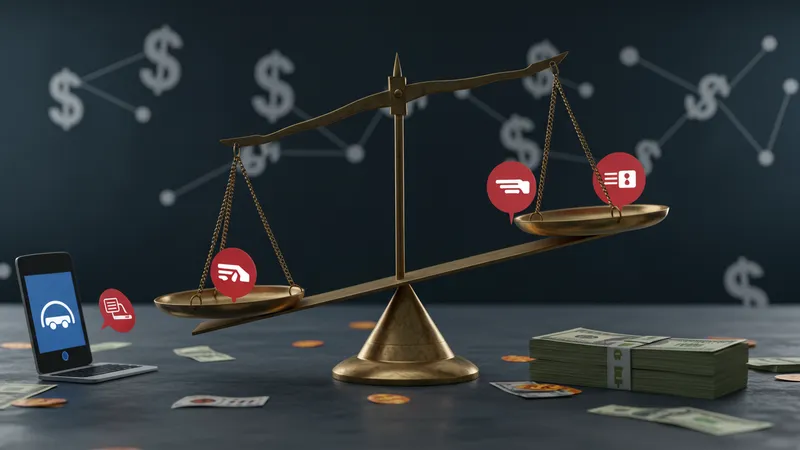Did you know that one AI-powered data tool can boost business efficiency by up to 50% in just a few months? The secret sauce behind these tools isn’t just fancy algorithms but a growing trend of affordable, life-changing technology.
As businesses adapt to a digital-first world, understanding data tools has become crucial. So why is everyone talking about them now? Because those who don't catch up may end up far behind in the competitive game. This isn't just future talk; it's happening right now.

Here's the twist: while big names dominate, there's a quirky underbelly of lesser-known data tools that outperform them, sometimes at a fraction of the cost. Companies are discovering that sometimes David can outsmart Goliath when it comes down to the price-performance ratio. But that’s not even the wildest part…
Even more astonishing is the realization that many businesses overpay massively by sticking to expensive tools without exploring alternatives. The result? A financial black hole that could easily be avoided with a little curiosity and research. But the real kicker comes when you discover how deeply these costs affect unsuspecting businesses’ bottom lines. What happens next shocked even the experts…
It might surprise you to know the majority of businesses don’t realize they’re ensnared in cleverly designed subscription traps. Companies often sign up for premium packages, lured by introductory offers, only to find themselves locked into costly plans. The little-known strategy? Businesses can negotiate existing subscriptions to unveil hidden cost-saving opportunities. But there’s one more twist…

Many executives think cancelling an underused service is simple, but deactivating certain data tools proves more complex than breaking a lease agreement. Think you're cancelling your account today? Think again. Some contracts require notice periods that stretch for months or involve fines if disrupted prematurely. What you read next might change how you see this forever.
Our insider sources suggest the key to resolving the subscription conundrum might lie within little-publicized channels, where customer retention specialists offer covert discounts to avoid client churn. Yes, negotiation with customer service can indeed dramatically slash your quote, but few know how to harness this power. You might assume these deals are hush-hush, but…
It turns out, dissecting the terms of service and prodding the right departments not only surprises with deductions but exposes an entire realm of flexible pricing models. Suddenly, what seemed ironclad transforms into an enigma of negotiable stipulations. But that’s just the beginning of unwrapping these subscription secrets…
Beyond the polished facade of mainstream tools, there exists a tapestry of underrated data solutions that get dismissed simply because they don’t appear in top-tier lists. These tools, often developed by startups, aren't just budget-friendly but offer niche functionalities that giants miss. Curious about who these underdogs are?

Consider platforms that integrate social media metrics with real-time customer engagement data — an invaluable combination for small to mid-sized enterprises crafting nuanced marketing strategies. Users report not only savings but also spikes in productivity — nothing short of transformative. But there's more to this dynamic landscape…
Think you've heard it all? Here’s something big: many data analytics tools are tailored for specific industries, like healthcare or retail, providing precision insights that off-the-shelf tools can’t rival. By aligning closely with sector-specific needs, these niche tools deliver beyond generic solutions. But surprisingly, they remain underutilized. So, what's the catch here?
It’s simply a matter of awareness. With the right insights, businesses can harness these hidden tools to unlock distinct advantages. Yet, too often the innovative gems slip by unnoticed because companies rely solely on brand recognition rather than breakthrough service efficacy. But this oversight could soon shift dramatically…
Freemium models are enticing, offering tools for free initially, but as businesses scale, they find their needs quickly exceed the limitations of unpaid services. What starts as a 'free' solution can metamorphose into a labyrinth of premium add-ons. Surprisingly, this model's potency lies in how adeptly companies maneuver between tiers.

Statistics suggest that fewer than 10% upgrade to full services within the first month, but those who do often spend double on features they don't use. The secret to avoiding this trap? Comprehensive assessment before any commitment can save unsuspecting businesses thousands annually. Yet, there’s more to unveil…
Moreover, certain freemium products mask their premium features behind sophisticated user interfaces, prompting users to engage with every enticing trial before revealing the steep scale-up costs. This small-time allure can evolve into a pricey affair, catching businesses off guard. So what’s the real play behind these seemingly generous offerings?
The surprising truth? Success hinges on vigilant evaluation of every tool against a business’s evolving requirements. Strategic utilization, coupled with clear-eyed understanding of potential costs, effectively negates hidden charges and curtails unexpected expenditures. What you discover next could redefine your budgeting strategy forever.
Open-source data tools are revolutionizing industries by providing access to high-quality resources with little to no cost. While they require some technical know-how, the adaptability offered is unparalleled. With nations like Estonia relying on open-source for government operations, what's stopping enterprises globally?

Astonishingly, almost 90% of businesses overlook these tools, influenced by the misconception that open-source equals inferior. However, the opposite is often true. Many open-source solutions are family jewels, maintained and enhanced by an engaged community that continually optimizes features. But the best part is yet to come…
Consider companies that have thrived by integrating open-source systems into their tech stack, saving not just money but fostering creativity and innovation. The flexibility to tailor solutions precisely to business needs results in unique advantages that competitors bound by rigid proprietary software cannot match.
Actually, thriving open-source communities offer extensive support — sometimes even surpassing customer service teams of paid tools. The potential collaborative enhancements one can glean from active forums can be a game changer. Yet, newcomers often remain oblivious to these powerful dynamics. The question is: how much longer will this resource remain underrated?
Automation tools are silently changing the face of business operations. This is not about replacing jobs but rather enhancing them, making processes efficient and precise. Intriguingly, some firms have shaved off 20% of their operational costs by deploying smart automation. Can you guess why they are the buried treasure?

The ability to automate routine tasks frees up critical human capital for more strategic endeavors. Reports suggest that enterprises utilizing automation experience remarkable productivity boosts, astonishing their complacent competitors. Why, then, is adoption still gradual in many industries?
One reason is the misconception that only tech giants can afford to incorporate high-level automation. But that's a myth busted every day as smaller companies adopt lighter, cost-efficient automation solutions with substantial success. So how do they manage to pull this off?
The answer involves a mix of creativity and strategic partner alignments, elevating smaller operations to swing above their weight. This technology is not just about tomorrow — it’s reshaping today in ways many still haven't grasped. But wait until you hear what futuristic potentials lie ahead…
DIY data analysis — think of it like hacking your data without hiring an army of analysts. For resourceful companies, leveraging simple spreadsheets and algorithms redefined efficiency. But shockingly, many businesses have yet to catch on to this cost-cutting marvel. Why is this practice still under the radar?

A blend of skepticism and reliance on oversold solutions blindsides decision-makers who could benefit from honing native skills. However, those daring enough to invest in training reap benefits with every insightful report generated in-house. This self-reliance ignites a transformation in workplace dynamics — are you imagining the possibilities yet?
Imagine harnessing vast troves of data and making sense of them with nothing but the relatively low-cost investment in team skill development. It's a strategy that cuts across industries, spawning innovation. The trend is rising, yet remains cloaked in a shroud of mystery to many. But challenges are turning into stepping stones…
Success tales of startups disrupting entire sectors via DIY data analysis are circulating. The capacity to pivot quickly, innovate rapidly, and act on insights instantly sets these businesses apart from legacy-bound juggernauts. What might happen if more companies dared to think small but impact big?
The ethics of subscription models have long sparked debate: are they designed for utility or profiteering? On one hand, they democratize access to premiere resources; on the other, they can ensnare unwitting clients in perpetual billing cycles. Yet the ethical quandary remains largely unexamined. What does this mean for consumer behavior?

Some argue that perpetual subscriptions reflect capitalism's unchecked ambition, monetizing unnecessarily while adding little incremental value. However, others point to their ability to empower smaller stakeholders to engage with high-caliber solutions once out of financial reach. Truly, both sides present valid arguments.
Pragmatically speaking, understanding and navigating these subscription waters is essential. By discerning personally meaningful versus commercially hyped features, businesses elevate their strategic trajectories. Savvy leaders unearth opportunities hidden between the lines, but why is their insightful intent often overlooked?
Ultimately, balancing moral considerations with economic realities offers a path of conscientious business growth. Those attuned to detecting ethical misalignments and negotiating just solutions discover not just savings, but avenues for industry influence. The journey beyond this discovery is nothing short of thrilling — the horizon holds boundless possibilities.
AI is stepping into the financial domain, spearheading reform in managing and predicting subscription costs. Automated systems now analyze spending patterns and predict potential savings, allowing companies to refine financial footprints with precision. How has AI become integral to these breakthroughs?

Through AI's lens, patterns emerge – redundant tools, underutilized features, and needless duplications – previously masked by complex billing structures. As these data revelations unfold, businesses gain unprecedented insights into optimization prospects they've never conceived of before. But the ramifications stretch further than imagined…
This tech evolution not only stabilizes cost commitments but revolutionizes business agility. Companies can now press ahead confidently, leveraging predictive analytics to buffer against future market volatility or unforeseen expenses. Yet, the narrative extends beyond mere financial stewardship. How does this evolution redefine strategic planning?
The capacity AI commands in transforming fiscal strategy translates directly into competitive edge. Organizations effectively pursuing such intelligence endorse technology as ally, cutting out guesswork and scripting future-forward perspectives. The landscape of tomorrow seems unpredictable, but with AI, clarity emerges like never before.
As digital economies mature, single-value metrics like subscriber counts are insufficient markers of a tool’s veritable worth. Businesses must pivot towards multidimensional analyses, juxtaposing cost against novel metrics like user engagement and versatility. Why is this new evaluation paradigm crucial?

Metrics historically focused on overhead often overlook intangible benefits that shape customer loyalty and product adaptability. These hidden assets contribute values narratives previously shrouded by outdated evaluative frameworks. Transitioning perspectives breaks barriers and welcomes new horizons.
Forward-thinking companies embracing holistic valuations discover true reflections of their digital investments' potential. They identify where user satisfaction correlates with profitability and design pathways for simultaneous operational impact and customer delight. Yet, the most fascinating aspect remains the catalyst role new metrics play in agile mindsets…
Transformative, these metrics illuminate relationships, accentuating facets like community engagement or feature flexibility—factors enhancing experiences and customer attachment. Armed with this knowledge, decision-makers craft responsive solutions that resonate deeply with target markets. How might this shift revolutionize the digital commerce we know today?
Shadow IT — unsanctioned tech tool usage — is often viewed through a lens of caution. However, it plays a pivotal role in how businesses adapt and respond to immediate operational needs. Is it a hidden boon, or an unsuspected bane for businesses striving towards technological cohesion?

This phenomenon signifies workers' innovative thrust, pursuing agility when traditional IT frameworks lag. Informal solutions bridge gaps swiftly; yet pose risks, from data breaches to security vulnerabilities. Curiously, rather than suppression, smarter mitigation strategies are emerging as key.
Empowering employees to safely innovate within supportive boundaries transforms potential liability into untapped ingenuity. Through policy adjustments, businesses can harness shadow IT to propel innovation, while mitigating risks through robust oversight and orchestration strategies. This duality in approach invites further exploration…
Ultimately, reconsidering shadow IT as not merely a rogue element but a fountain of decentralized innovation could revolutionize traditional IT perspectives. Cultivating an inclusive framework that harnesses this potential might be the next frontier in cultivating dynamic, responsive, and resilient enterprises.
Looking forward, the trajectory for data tools and analytics suggests a rich tapestry of evolution. From intuitive user experiences to real-time insights, these technologies eagerly anticipate broadening their horizons. What advancements are predicted to define future data explorations?

Emergent trends already highlight seamless data sharing and automation as staples, fostering collaborative workspaces transcending geographical barriers. Anticipate even sharper tools that harness communal data insights for curated recommendations that surprise and delight. But the scope doesn't end here…
With AI’s constant refinement, anticipation surrounds tools that learn in tandem with their users, growing smarter over time to meet changing demands with uncanny precision. Proliferation of personalized analytics allows businesses to foresee trends before they burgeon into fully-fledged shifts, redefining strategic foresight.
The drive toward comprehensive data democratization signals a future where analytics bridges divides, opening the doors of understanding wide. Ponder the possibilities on the horizon, where not only is data powerfully accessible, but knowledge becomes universally actionable. How will this transformation reshape industries and personal lives alike?
Once a fringe concept, data sharing economies are now gathering momentum. Companies glean insights from open data pools, reciprocally contributing with proprietary datasets. This approach cultivates community wisdom, transforming competitive advantage into collaborative growth. But what about the economic dynamics this inspires?

Equitable participation and mutual benefits underpin this novel ecosystem. Data diversity promotes richer analyses, enabling precision-driven solutions across sectors. Further, this confluence encourages novel partnerships and alliances—synergies that conjure unparalleled innovation.
Moreover, these shared economies erode traditional silos, enabling seamless collaboration that intersects industries and uncovers unimaginable opportunities. The democratically-driven data access fosters ethical evolution, influencing practices and policy holistically. But the transformation has unexpected implications…
As legacy paradigms adapt, businesses comprehend data as a shared asset, leading to economies sculptured not by possession but by participation and value creation. The implications of these shifts possess the power to reshape not just economies, but societal structures themselves. How deeply might this reach by redefining such fundamental operations?
The convergence of data analytics, automation, open-source revolution, and shared economies heralds an era of empowerment and innovation. Businesses stand on the precipice of extraordinary evolution, armed with tools, insights, and frameworks that align efficiency with creativity. Ready to seize these dynamic opportunities, they must actively engage in rethinking potential, challenging constraints. Share this journey, bookmark the future, and embrace the boundless horizons of data mastery.